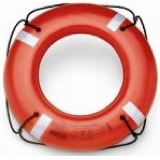Information
-
Installation:
-
Conducted on
-
Conducted by:
-
Conducted by:
3.1 TEMPSC
-
3.1.1 Does MODU meet the OPQL Requirement of 200% POB TEMPSC seating capacity.<br>
-
3.1.2 Are the TEMPSC distributed 100% POB either side of Rig.<br>
-
3.1.3 Are TEMPSC's fitted with cascade manifold system to 100% of seating capacity.<br>
-
3.1.4 Emergency lighting is provided in the lifeboat muster area<br>
-
3.1.5 Are all access paths to escape capsules or lifeboats clear of obstructions<br>
-
3.1.6 Is each TEMPSC marked with Vessels name, registry and capacity<br>
-
3.1.7 The bilge is free of oil, water, etc.
-
3.1.8 Safety signs are posted and visible<br>
-
3.1.9 The fire protection systems are adequate and properly maintained<br>
-
3.1.10 The fuel shut-off valve is in the open position<br>
-
3.1.11 The throttle control is in the open position<br>
-
3.1.12 The gear shift is in the neutral position<br>
-
3.1.13 The hydraulic control gauge reads between 2500 - 3000 psig<br>
-
3.1.14 There are spare life preservers located inside the capsule or nearby storage box<br>
-
3.1.15 The compass is in working order<br>
-
3.1.16 The capsule or lifeboat engine has been run at least once per month for at least 5 minutes<br>
-
3.1.17 All battery connections are tight and well lubricated<br>
-
3.1.18 All belts, hoses and hose connections are tight in good physical condition<br>
-
3.1.19 The fuel tank is full and fuel has been changed within the last year<br>
-
3.1.20 The transmission and hydraulic systems and other oil levels are up to normal levels<br>
-
3.1.21 All capsule flares (all types) in good physical condition and not expired<br>
-
3.1.22 The First Aid kit is complete, with all packs wrapped in cellophane<br>
-
3.1.23 There is an explosion proof flash light in the capsule complete with current and spare batteries available<br>
-
3.1.24 The capsule has a survival kit that consists of hatchet, fishing line, fish hook, mirror, and knife as a minimum<br>
-
3.1.25 The capsule's sprinkler system is operational and has enough water to prime the system<br>
-
3.1.26 The launching system is in good working order<br>
-
3.1.27 The hand stop, wire rope, U-clamps, motor and motor starter are all in good order<br>
-
3.1.28 All sheaves and blocks are properly greased<br>
-
3.1.29 Davit Fall wires adequately lubricated<br>
-
3.1.30 Safety lines are attached during drills and maintenance and removed at all other times<br>
-
3.1.31 Davits and boats are load tested. Date of last load test stencilled on Davit.<br>
-
3.1.32 The retrieving limit switch works properly<br>
-
3.1.33 All employees have received training in how to operate the capsule and/or lifeboats<br>
-
3.1.34 Is a Fixed VHF radio available for each TEMPSC<br>
-
3.1.35 Is a GMDSS handheld radio available for each TEMPSC<br>
-
3.1.36 Is an EPIRB available for each TEMPSC<br>
3.2 Liferafts
-
3.2.1 Does MODU meet the OPQL Requirement of 100% POB Liferaft capacity.<br>
-
3.2.2 Are the Liferafts distributed 50% POB either side of Rig.<br>
-
3.2.3 Raft and container are intact and not damaged<br>
-
3.2.4 Rubber seal on raft and container is free from damage
-
3.2.5 The last inspection of raft and container is dated within the last 12 months<br>
-
3.2.6 The raft and container is clean and free from oil and grease<br>
-
3.2.7 Each Raft and container is properly marked with the capacity of personnel<br>
-
3.2.8 The cradle for each inflatable liferaft is properly sized<br>
-
3.2.9 The cradle for each inflatable liferaft is easily accessible, with no launching obstructions<br>
-
3.2.10 The cradle is bolted - not welded to deck<br>
-
3.2.11 The liferaft release mechanism is free from rust and corrosion<br>
-
3.2.12 The release mechanism has been inspected within the last year and can be easily adjusted<br>
-
3.2.13 The turnbuckle on liferaft container is free from rust and corrosion<br>
-
3.2.14 The hold down cable on liferaft container is in good condition<br>
-
3.2.15 Operating & Launching instructions are posted at each liferaft station<br>
-
3.2.16 Each liferaft station is clearly marked and conforms to Station Bill<br>
-
3.2.17 If Davit launched - note date of last davit load test.<br>
3.3 Lifering Buoys
-
3.3.1 There are an adequate number of ring life buoys present.<br>
-
3.3.2 All Ring buoys are in satisfactory condition.<br>
-
3.3.3 All Ring buoys are easily removed from their brackets.<br>
-
3.3.4 There are an adequate number of water lights and smoke signals attached to ring life buoys.
-
3.3.5 A rope is attached to at least one ring buoy on each side of the vessel that is 1.5 times the distance to the water or at least 90 feet, whichever is greater.<br>
-
3.3.6 All Ring buoys are in their proper location.<br>
-
3.3.7 All Ring buoys have the name of the vessel and its port of registry indicated.<br>
3.4 Floatation Aids
-
3.4.1 There is enough life preservers to provide 200% coverage of persons on board at any time<br>
-
3.4.2 Life preservers are in good condition, approved and labeled with the name of the vessel<br>
-
3.4.3 There are spare life preservers stored in marked boxes.<br>
-
3.4.4 Each state room is equipped with the proper number of life preservers stored atop the lockers<br>
-
3.4.5 Life preservers are equipped with whistles, reflector tape, and lights<br>
-
3.4.6 There is an adequate number of work vests provided for all personnel baskets<br>
3.5 Other
-
3.5.1 Are Escape ladders provided and maintained.<br>
-
3.5.2 Are Escape ladders are ready for fast deployment.<br>
-
3.5.3 Are Line throwing guns provided, properly maintained and within expiry date. <br>
-
3.5.4 Is an Emergency portable spot light readily available (for Man overboard emergencies )<br>
3.6 Administration
-
3.6.1 TEMPSC Davits and boats load test certificates<br>
-
3.6.2 Liferaft Davit load test certificates<br>






